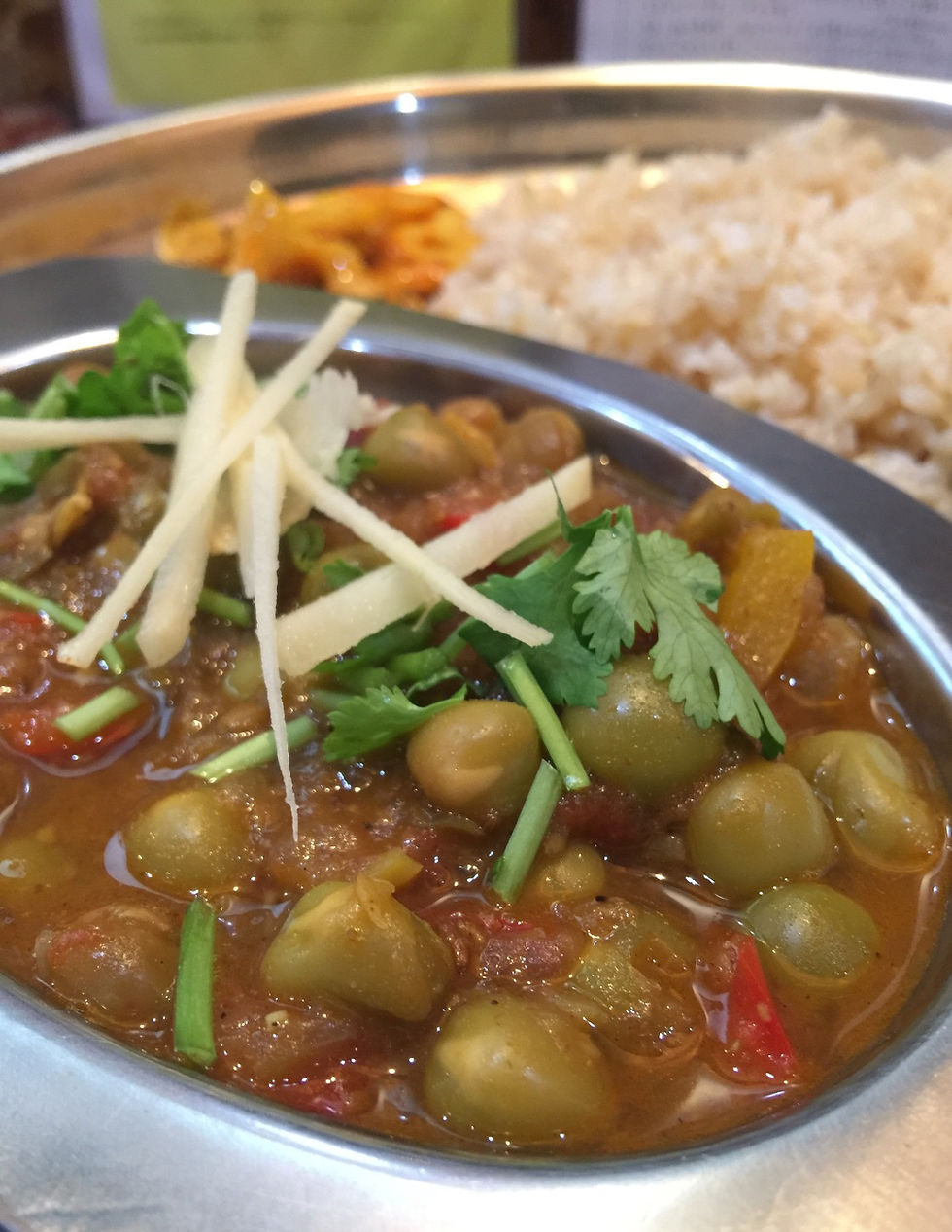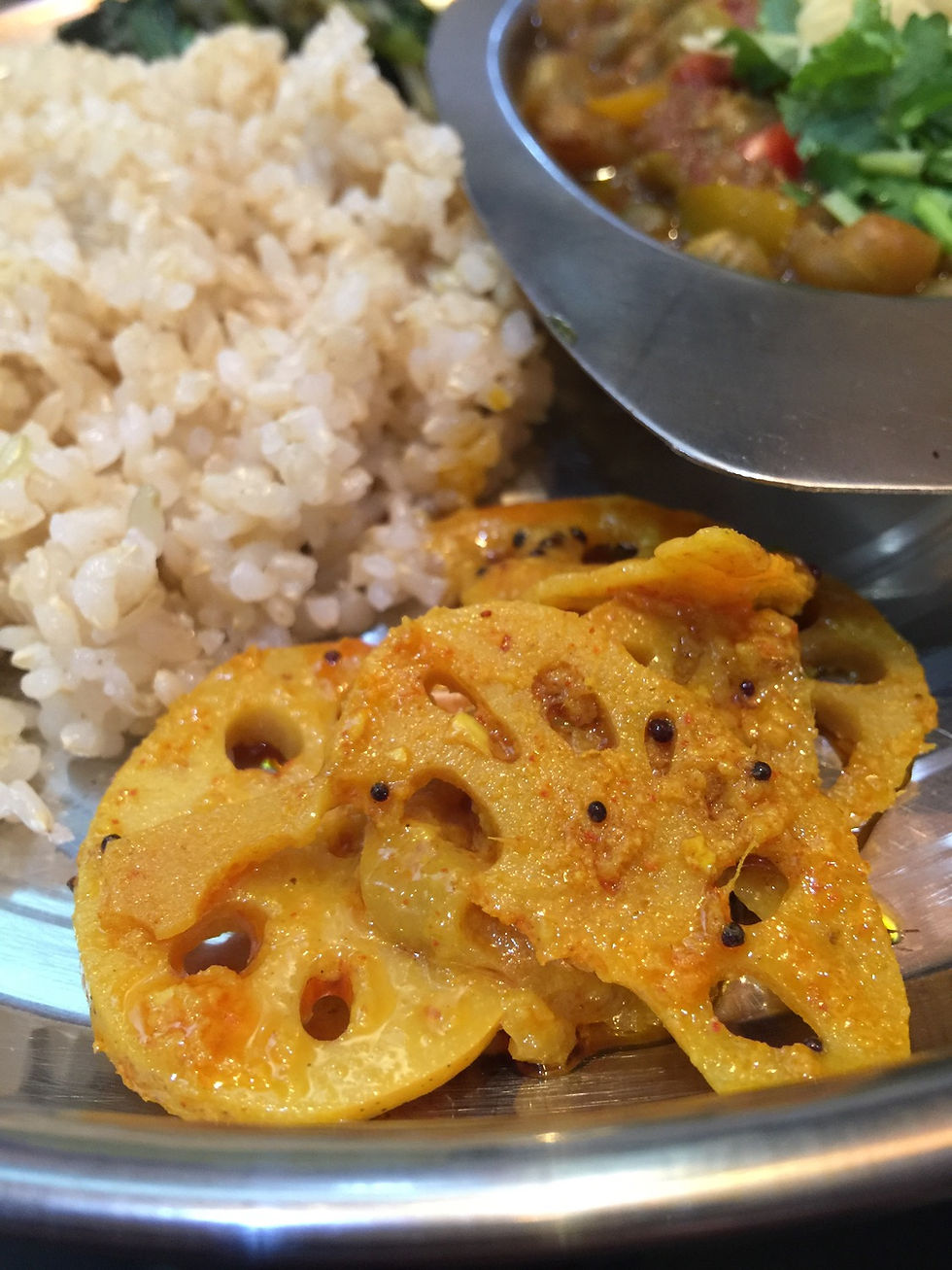
It has become the new custom in the ever growing "spice curry*" genre in Osaka to offer one (or two) staple curry(s) and one weekly curry; or one meat based curry and one vegetarian. In the carnivore-pescatarian Osaka, spice curry is more often than not the safest bet in finding edible nosh for vegetarians/vegans around lunch time (since many are not open for dinner). (*A Japanese curry is usually made from "roux" in the shape of tablets, to be broken and added into stewed meat and vegetables, resulting in a spicy brown stew, whereas the new "spice curry" eschews the "roux" and is made from scratch - the ground or whole spices.)
At Sacche's Curry, the week begins on the Saturday: two new weekly curries appear on the menu along with the staple of keema curry. One of the weekly curry is a meat or fish based gravy, while the other is vegan. With only three curries on offer, the menu is surprisingly long since it is inscribed with minute instructions - i.e. more rice (Y100), more curry (Y100), more shredded ginger (free), more sides (Y200 and subject to availability of "time") or larger servings of sides (free during lunch). However, this level of details is not a testament of the chef's particular peculiarity, but rather, it is a silent appeal to the customers to only order what they want to eat and care to finish. Sacche has lamented on her Facebook page: "people don't eat the vegetables and they sometimes find the pickles too much." It is sadly true that the Japanese society is so saturated with rich food that they are rather offended when offered mere "vegetables" on the plate. (But this is another topic.)
Bell pepper and matar masala (weekly vegan curry):
It is the season for fresh peas in Japan; however, dried matar from India was used instead. While this variety of large peas did stand up, arguably, better against the more complex spices typical of the Northern recipes, Sacche has committed a fundamental and unforgivable error where no real Indian chefs would be caught making: the peas were not cooked properly through so that they still felt dry and hard, a little too tooth-some, in the deadly literal sense.
The gravy, however, was spiced up nicely and salted authentically. Sacche, as usual, garnished the curry with her signature julienned ginger, which tops almost all her curries, heedless and regardless of ingredients or region. Fortunately, in this case (usually a 50-50 chance), the ginger matched the flavor, but she will not leave it at that. Further added were the coriander leaves as an (unnecessary) embellishment. Japanese "spice curry" chefs often commit this kind of faux-pas by adding an "extra" touch, which is just a bit too "extra-neous." They do so out of their sincere, albeit mistaken, belief that curry must be complex.
It is true that Japanese cuisine is known to be "simple" (or simplistic) and its modus operandi is deduction rather than addition. It is also true that Indian cuisine is more complex in its use of ingredients (if not necessarily techniques) than the Japanese. Yet, the guiding principle in cooking any cuisine is still to know "when to stop": it is a fight between fear of not enough and fear of too much. Given that most of the general palate is geared toward the salty and fatty, and coupled with the fact that the Japanese do expect their curry to be burningly spicy and mindbogglingly complex beyond easy digestion or comprehension, the Japanese chefs do use more spices in curries than actually and commonly used in India - both in quantities and types. For example, they often (too often) sprinkle dry fenugreek leaves on the plate as a garnish, irrespective and disrespectful of the authentic recipes filled with age-old wisdom.
Sacche, while admonishing against the lackadaisical use of fenugreek leaves, failed (yet again) to restrain her hand from adding that one little "extra" but unnecessary touch.
On the plus side, she does try to use better ingredients and cooks in a healthier way - i.e. brown rice, less oil, etc. And her pickles - this week was lotus root - are usually nicely adapted - less oil and less salt - to the Japanese ingredient and climate, while maintaining the acidity and texture to accentuate a meal. But, her vegetable side dishes are more of a hit-or-miss: this time, the spinach and bean sprouts sabzi could have appeared in any Chinese take-out, especially with the stale taste of oil.


Having said that, a meal at Sacche's is always wholesome and flavorful, if only within the "spice curry" genre, which seems to be swallowing up the young and eager curry chefs in Japan. What happens after the boom is gone remains to be seen.